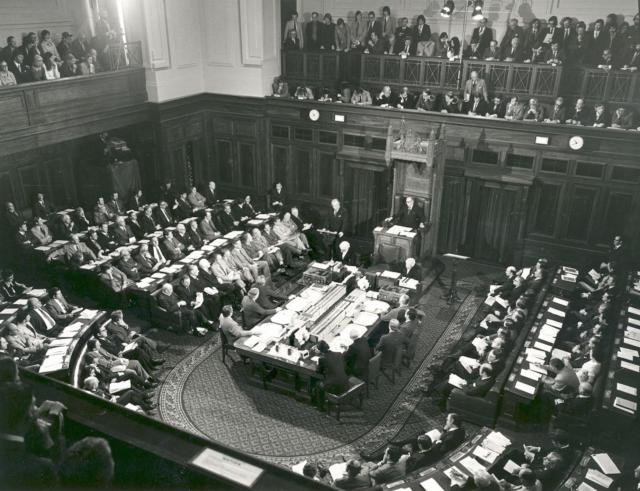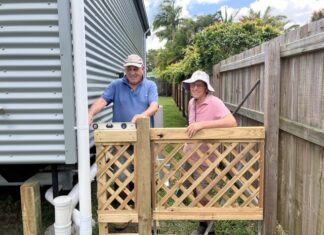PHIL JARRATT recalls a night that started a new era in Australian politics, and kept him out of the army
Fifty years ago today, on 2 December 1972, I spent the morning at a polling booth in the Canberra suburbs, handing out how-to-vote cards for the local Labor MP Kep Enderby, before heading off to work at the National Tally Room at Belconnen High School in one of the new housing estates that had been built to cater for the capitol’s huge public sector growth.
To say that I was somewhat invested in the outcome of that day’s federal election is a gross understatement.
A victory for Labor and its enigmatic leader Gough Whitlam would be my escape tunnel from the two years of military service from which I’d been granted a deferment to complete my journalism studies, and which would expire at the end of the month.
If Gough didn’t make it to the Lodge, I’d be in khaki! This reality had dawned on me a few months into my year in Canberra, and I’d decided to do something about it.
While faking the impartiality required of me every day as I donned my suit and went to work as a junior reporter in the political bureau of the Sydney Morning Herald, I was, in fact, a card-carrying member of the ALP who believed with all his heart in the gospel of Gough, that it would lead to the creation of a new and fairer Australia, not to mention the abolition of conscription.
I’d volunteered for Enderby, a former barrister, good bloke and scratch golfer who would later become attorney general, since his first call, and although I wasn’t allowed to have an opinion in my writing for the Herald, like a lot of partisans in the press gallery, I wrote extremely pro-Labor pieces under assumed names for scurrilous left-wing rags like Nation Review and the surfing magazine Tracks.
I was 21 years old, able to vote for the first time and determined that the will of the Australian people be bent in my general direction.
Of course, it helped that a great many voters of all persuasions felt that after 23 years of conservative government it was indeed time for a change – “It’s time” as Gough sang merrily along with pop stars Jimmy Hannan, Col Joye, Little Pattie, Allison McCallum and many others in the first campaign theme song in Australian political history, which came blaring out at us from our little black and white TV screens.
And it didn’t hurt that the incumbent Coalition Prime Minister Billy McMahon was widely seen and hilariously satirised as the worst leader in living memory – “Tiberius with a telephone” he was dubbed as only Whitlam had the intellectual capacity to do, after hearing reports of Billy’s Liberal colleagues being subjected to late night harangues.
But there was far more to it than a glib slogan and some clever marketing.
Regardless of the largely self-driven disasters that would befall his government over the next three years, on 2 December 1972, Gough Whitlam led the Labor Party into the election with the most expansive agenda for change in modern Australian political history. More than 200 policy promises were presented, from education to Indigenous rights, universal health care to electoral reform, equal pay, and no-fault divorce.
As Professor Jenny Hocking noted many years later: “It was a platform that reflected years of policy development and internal party struggle through the 1960s, in what was then a deeply divided Labor party. It also marked a dramatic shift from the post-war political certainties of Menzies.”
And its impact is still felt today.
Earlier this month, delivering the 2022 Whitlam Oration in Blacktown, the western Sydney venue for Gough’s campaign launch 50 years ago, Foreign Minister Senator Penny Wong reflected on the lessons we can learn from Whitlam and outlined her government’s plan for a future of foreign affairs informed by his legacy.
In 1972 I didn’t know any of this but I was a true believer anyway as I drove my 1961 VW Beetle out to Belconnen for the count.
It was just an ugly high school auditorium, but in the late afternoon as the TV channels did their tech checks, journos hovered in packs looking for a drink and the public started wandering in to check the action, the Belconnen High tally room started to hum with excitement.
This was the first federal election I’d covered, so I had nothing to compare it to, and I was unaware that this was also the first time there had been an Australian Electoral Commission tally room at Belconnen or anywhere else.
But the tally room would become an Australian institution, right up until the digital revolution finally killed it in 2010.
By 7pm, and an hour after the polls closed in the eastern states, the excitement was palpable. While the heavy hitters from my office moved around getting reactions from senior pollies and making fearless predictions for the television cameras, as the first numbers appeared on the manual tally board, my job was to phone around getting reaction quotes from sitting members who looked in danger.
It was a nightmare, compounded by the frequent dropouts on the temporary phone lines set up for the night.
It went like this: “Good evening, sir. Are you looking at the latest numbers? It looks like you might be gone.”
“Too early to tell, you impertinent little bastard.” (Hangs up with force.)
Within the one-eyed confines of the press gallery, we had predicted a Whitlam landslide.
It wasn’t, but it was still comprehensive enough to file last copy on the teleprinter and get to the after-party while it still had legs. (It wasn’t long before I didn’t.)
I remember forcing myself into a victory huddle with Mike Willesee, Mungo McCallum, Mick Young and my colleagues John Stubbs and Ian Frykberg, all dead now. It was 50 years ago, what would you expect!
It was a night of nights, we were full of beer and hope, I loved my life and I wasn’t going into the army. Yay!









